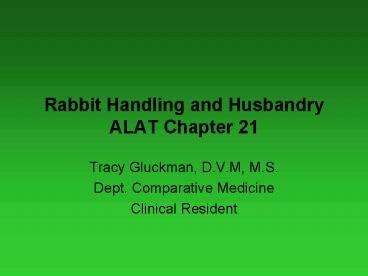Rabbit Handling and Husbandry ALAT Chapter 21 - PowerPoint PPT Presentation
1 / 18
Title:
Rabbit Handling and Husbandry ALAT Chapter 21
Description:
Behavior and response reflects prey ... Urethral opening (penile tip): rounded. Females (does): Vaginal opening: central line. male. female. Reproduction ... – PowerPoint PPT presentation
Number of Views:156
Avg rating:3.0/5.0
Title: Rabbit Handling and Husbandry ALAT Chapter 21
1
Rabbit Handling and HusbandryALAT Chapter 21
- Tracy Gluckman, D.V.M, M.S.
- Dept. Comparative Medicine
- Clinical Resident
2
General Information
- Oryctolagus cuniculus
- New Zealand White (NZW) rabbits most common
breed in the research environment. - Behavior and response reflects prey status in the
wild nervous, flight reactions, covert pain
manifestations.
3
Rabbit Research Models
- Common use for rabbits in research
- Serum antibody production ascites
- Drug testing/screening toxicology, pharmacology
- Pyrogen (fever) induction
- Atherosclerosis arterial plaque formation
4
Handling and Restraint
- Manual v. device restraint
- Slow, calm movements
- Cage removal One hand at scruff and one hand
always supporting hindquarters. - Vertebral column fracture (7th lumbar vertebrae)
- Never lift or move a rabbit by the ears
- Pinnal (external ear) cartilage trauma
- Transport Tuck head under arm, support
hindquarters. Short distances only! - Transport carrier for longer distances.
5
Initial transport
Cage Removal
Walking transport
6
Restraint Device
- Snug fit
- Easy access to ears,
- musculature for sedation
- and minor procedures
- treatments
- intramuscular/intravenous/subcutaneous
- drug or fluid administration
- tattooing
- blood collection
- Never leave a rabbit unattended !
7
Manual restraint for health examination
- Head, abdomen, thorax, genital area
- Neck restraint at scruff
- Gently rotate rabbit onto back
- Access to genital area for sexing
- Access to oral cavity
- Always support the hindquarters !
- Always keep the rabbit calm !
8
Physiologic Data
- Body Temp 100 - 104F (38 - 40C)
- Heart Rate 130 325 bpm
- Respiratory Rate 30 60 bpm
- Weight (adults) 2 6 kgs
- Weight (kits) 0.02 0.08 kgs (20 80g)
- Average Lifespan 5 8 years (captivity)
9
Nutrition
- Obligate herbivores
- Prefer high protein, low carbohydrate feed
- Water consumption 50 100ml/kg/day
- Food consumption 50g/kg/day
- Cecotrophes (night feces) soft stool with thick
mucus consumed (coprophagy) to supplement
protein, water and B-vitamins. - Day feces dry, round pellets
- Urine yellowish (brown or reddish) /- cloudy
appearance from high mineral content
(calcium/phosphate/ammonium). - Male urine has very strong odor.
10
Sexing
- Urogenital examination
- Males (bucks)
- descended testicles within an external scrotum
(open inguinal canals) - Penis gentle caudal pressure at prepuce
- Urethral opening (penile tip) rounded
- Females (does)
- Vaginal opening central line
male
female
11
Reproduction
- Polygamous species no bonded mating pairs.
- Puberty at 5 7 months
- Reproductivity males 5 6 years, females 1 3
years. - Males can breed up to 5x/week
- Buck moved to does cage for breeding
- Females are very territorial
- Males will scent mark
- Sexual receptivity can be determined in 15 20
min. - No distinct estrous cycle. Period of receptivity
marked by swollen vulva, behavior change. - Induced ovulators ovulation 10 13 hrs
post-coitus.
12
Reproduction (continued)
- Gestational period 29 35 days
- Average litter size 4 10 kits
- Kindling (parturition) nest box or nesting
material 3 4 days before kindling. Dewlap hair
plucked for nest. - Kindling early morning, 30 60 minutes
- Doe first litter Do Not Disturb! Stress can
promote cannabalism. - Altricial young helpless, blind.
13
Behavior
- Curious actively play with cage toys
- Prey species
- Nervous around loud noises
- Cower in corner
- Run, kick, jump, bite or vocalize when stressed
- Aggressiveness lunging, stopping, biting
- Diurnal research rabbits primarily.
- Most active early a.m., early p.m.
- Rest with even weight distribution
- May lie in lateral recumbency (on side)
14
Diet
- Water must be available ad libitum (free choice)
- Rabbits have very high water requirements.
- Condition the rabbits to use automated lixits.
- During water deprivation, rabbits become
anorexic. Always check water source. - Standard feed high fibre, lower protein.
- High gastrointestinal transit time 6 8 hours.
- Coprophagy 3 8 hours post-meal.
- First signs of illness loss of appetite,
decreased stool production
15
General Husbandry
- Ambient temperature 61- 72
- High temperatures can increase shedding and lead
to gastrointestinal obstruction from hairballs
(trichobezoars). - Rabbits excrete a high percentage of minerals
(primary calcium) in the urine and high ammonia - Cage pans cleaned 2 3x/week. Urine minerals
can cause scale accumulation. - Cages washed every 2 weeks
16
General Husbandry Cage Design
- Indirect bedding systems avoid contact with
feces - Slated flooring filter down feces
- Gated fronts non-stressful observations, good
ventilation - Ventilation 10 15 air changes/hr
- Ammonia accumulation
17
General Husbandry
- Rabbit teeth grow continuously.
- Malocclusion (poor tooth alignment) can lead to
tooth - overgrowth.
- Clinical presentation inappetance, weight loss
and oral trauma.
18
Questions??
















![Chapter 18: Cold War Conflicts [1945-1991] PowerPoint PPT Presentation](https://s3.amazonaws.com/images.powershow.com/7237467.th0.jpg?_=20151008125)














